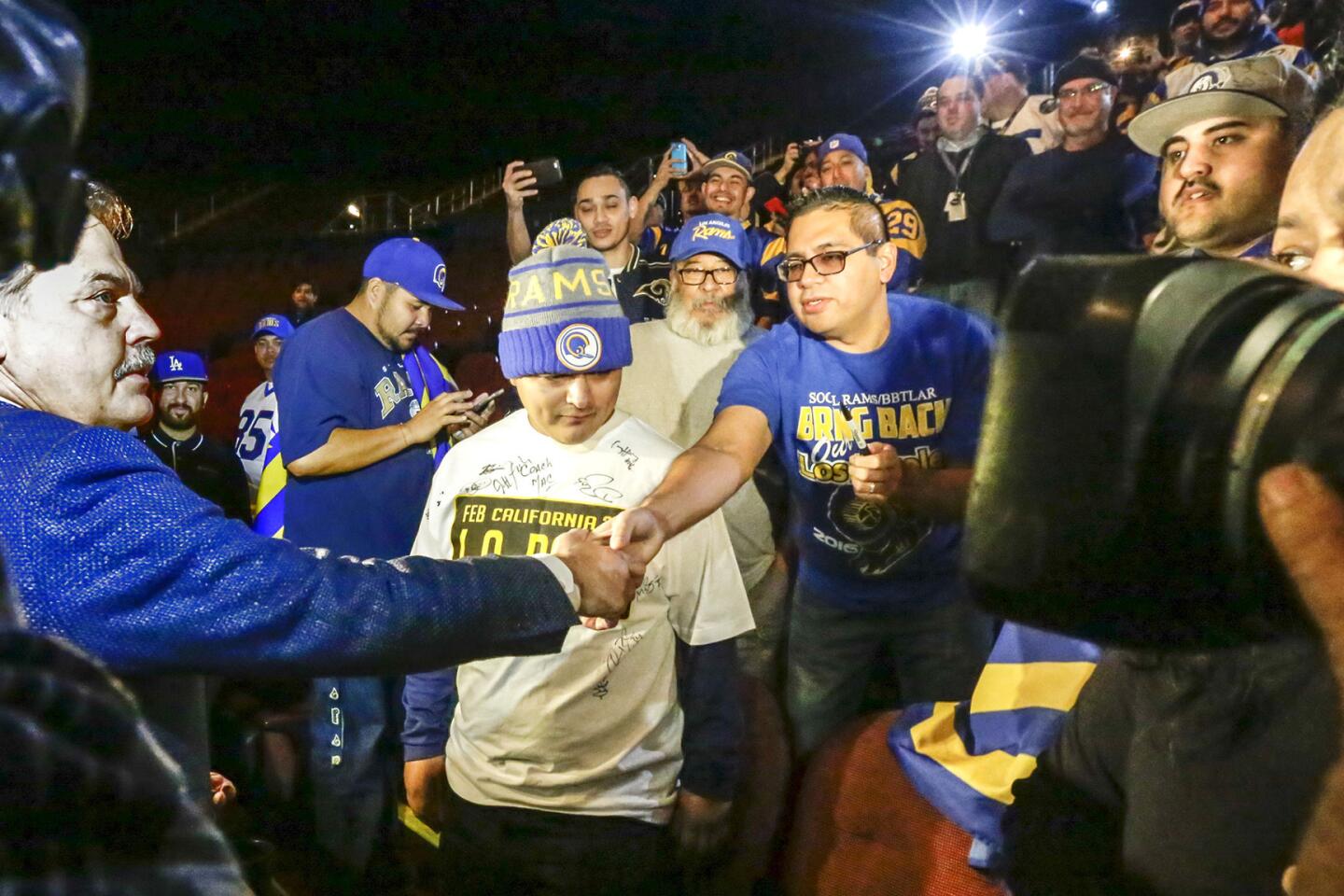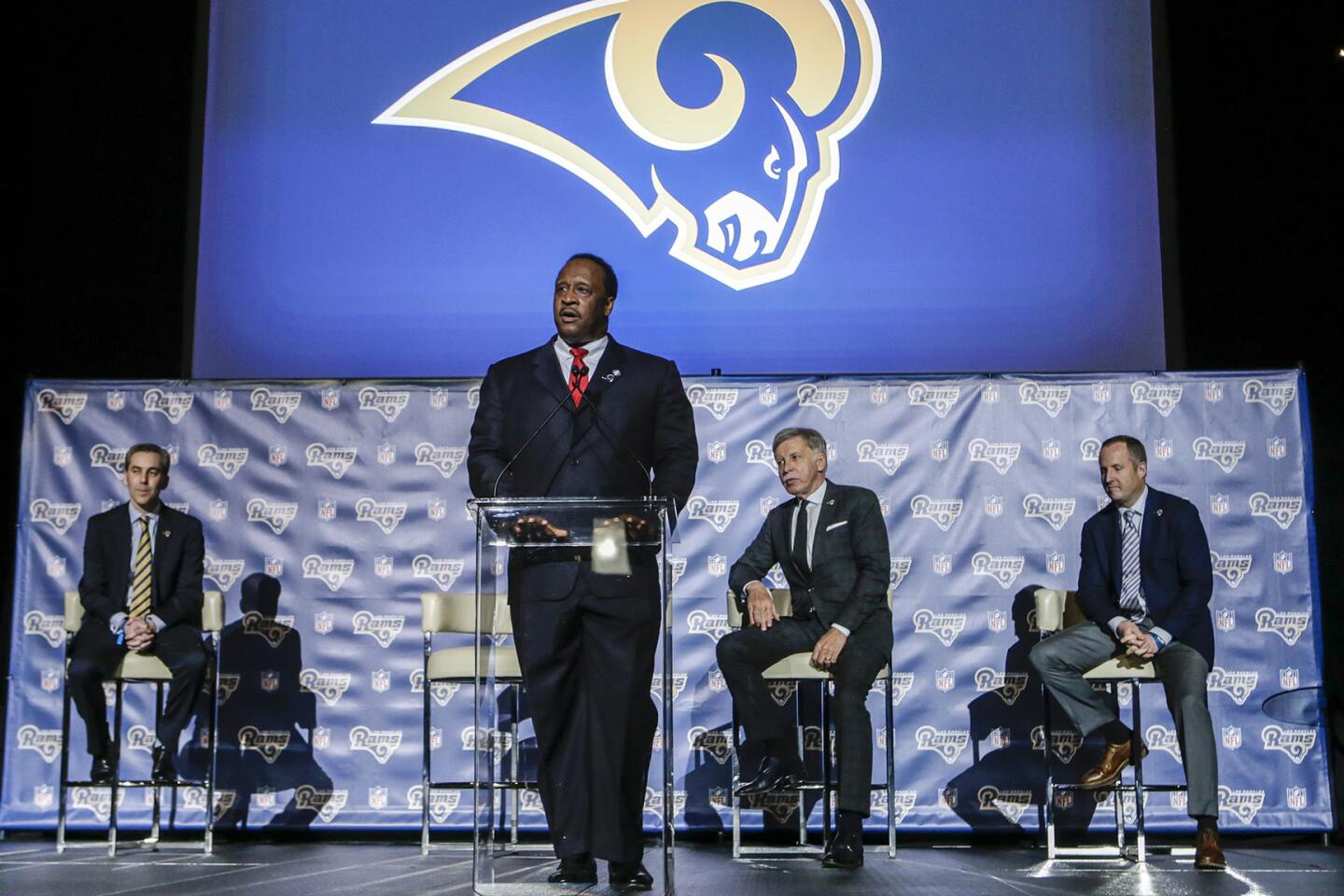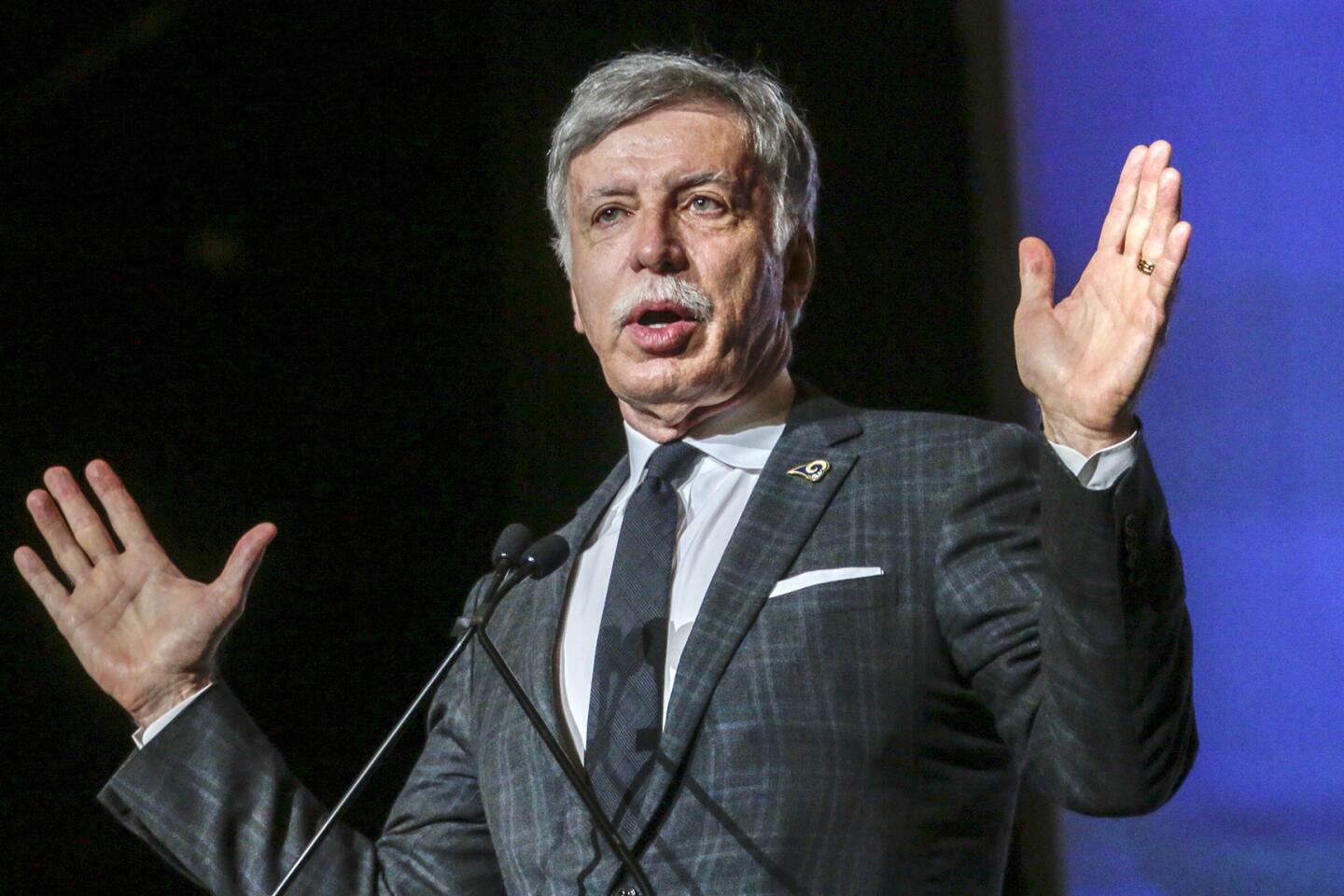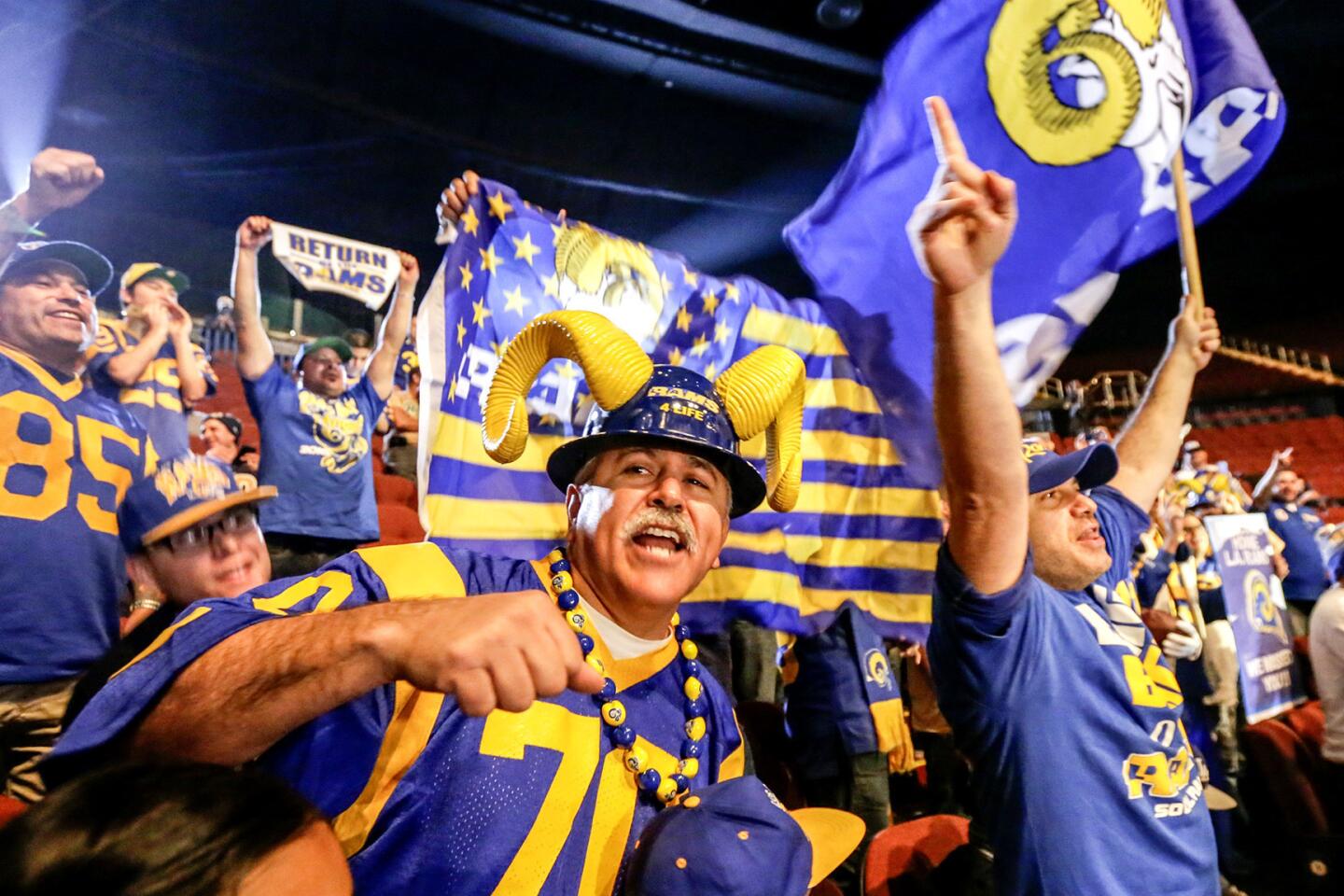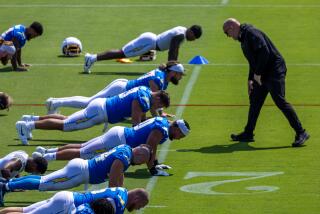A behind-the-scenes look at a Rams’ proposal the NFL couldn’t refuse
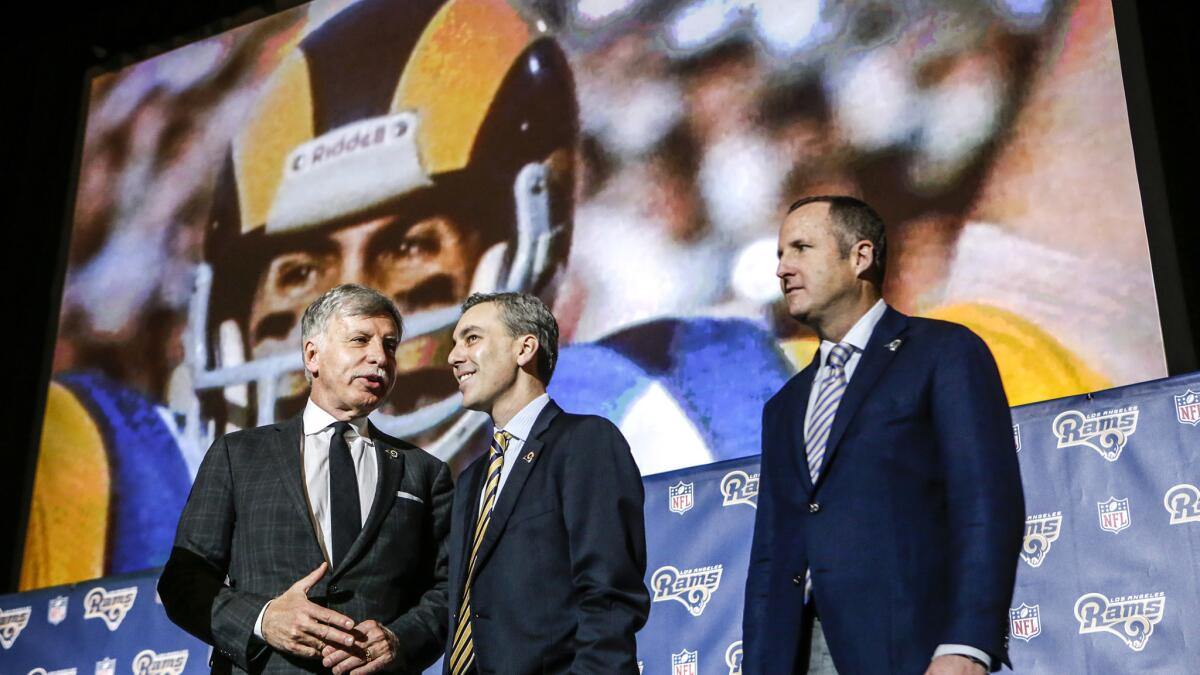
Rams owner Stan Kroenke, left, is joined by chief executive Kevin Demoff, center, and Chris Meany of Hollywood Park Land Co. after the news conference to formally announce the team’s return to L.A.
- Share via
Reporting from Houston — The final steps in the National Football League’s return to Los Angeles began behind closed doors — with a coin flip.
The St. Louis Rams won the right to go first, and their owner and a top executive made their pitch in the hotel ballroom, outlining plans for a multibillion-dollar stadium in Inglewood.
Next came the backers of the Carson stadium proposal — the owners of the San Diego Chargers and the Oakland Raiders. Recruited to oversee that project was Disney Chairman and CEO Robert Iger, who spoke of his love for the NFL and his branding expertise and reminded the 32 owners that, as head of ESPN’s parent company, he had paid them all plenty of money over the years.
After Iger left, Dallas Cowboys owner Jerry Jones pushed back his swivel chair and stood to address the room.
“He said he paid us. Last time I checked, that money is coming from Disney shareholders, not him,” Jones said, touching off laughter.
The moment of levity was a bad omen for the Carson project.
For 11 hours on Tuesday, the owners of America’s most profitable sports league — with $10 billion a year in revenue — were cloistered in the Azalea Ballroom of a Westin hotel just a short drive from an airport and their private jets.
Their mission: to pick the teams and stadium that would bring professional football back to L.A. after a 21-year hiatus.
::
Since the Rams and Raiders left Southern California following the 1994 season, numerous sites had been proposed for the NFL’s return. They included downtown L.A., Anaheim, Irvine, the City of Industry, the Rose Bowl, the Coliseum and even Chavez Ravine.
Every proposal failed. Los Angeles had made it clear that no taxpayer money would be spent to lure a team.
In many ways, L.A. was more valuable to the NFL without a team. The city was leverage, a threat that teams could use to extract public financing for new stadiums in their home cities.
See more of our top stories on Facebook >>
Things changed when Rams owner Stan Kroenke bought 60 acres of land next to the former Hollywood Park racetrack and a year later in 2015 revealed plans to build a stadium. What set Kroenke’s plan apart from past proposals was a crucial fact: He already owned a team that could be moved.
At the time he didn’t commit to returning the Rams to L.A. from St. Louis, but the implications were clear.
Six weeks later, a competing proposal emerged: The Chargers and Raiders wanted to construct a stadium on the site of a former landfill in Carson.
In between the two announcements, the NFL created a committee of six owners to evaluate stadium options in L.A. and any possible relocation. NFL owners met repeatedly to hear presentations on the two L.A. projects as well as those in the three home markets trying to keep their teams.
San Diego and St. Louis eventually assembled stadium proposals that included hundreds of millions of dollars in public financing, although San Diego’s hinged on a public vote later this year. Though Oakland city officials said they wanted to keep the Raiders, they did not offer the team any financial incentives or formal plan.
On Jan. 4, the three teams, citing dissatisfaction with their stadiums and the proposed remedies from their home cities, applied to move to L.A.
The NFL made it clear that the owners believed the L.A. market could support one team, and probably two, but not three. Among other things, there weren’t enough slots for broadcast outlets for three teams, and the city already had huge football fan bases for college teams, such as UCLA and USC.
At least one professional football team was going to be turned away.
By the time all the owners gathered here Tuesday, they were impatient for a deal. Four of the six owners on the L.A. committee had teams in the playoffs and another was in the midst of a coaching search.
The league set aside two days for the meeting, but most of the owners wanted to resolve it in one. Nevertheless, the league had reserved hotel space in Dallas for the following week just in case.
The details of the daylong session were pieced together from interviews with multiple owners, team executives and league officials, most speaking on the condition that they not be identified when describing confidential negotiations.
The Rams opened their presentation with 30 renderings showing the sleek, low-slung stadium and surrounding development they wanted to build in Inglewood.
Get the latest in sports with our free newsletter >>
Kevin Demoff, the team’s chief operating officer, said this would be much more than a stadium for one or two teams; the campus could house other league business ventures, such as NFL Network and NFL.com. Kroenke also spoke about his passion for the multibillion-dollar project.
The team’s pitch closed with excerpts from two columns by Bill Plaschke of The Times pleading for the Rams to return to L.A. The Rams, Plaschke wrote, had deep roots in the community and they were Showtime before the Showtime Lakers.
Chargers owner Dean Spanos and Raiders owner Mark Davis made brief comments about the Carson proposal.
Then Iger took the floor. One of the world’s most powerful entertainment executives, he had been brought on two months earlier to lead the project if it were approved. He talked about how he had come to appreciate the stadium’s location, which he has said was ideal for the two franchises because it had good freeway access and was close to Orange County.
In a corner of the ballroom, league staff had installed a computer and printer to generate paper ballots of new resolutions.

Sam Farmer, Nathan Fenno, Gary Klein and Lindsey Thiry discuss the Rams’ first news conference since returning to Los Angeles.
When it came time to begin voting, the owners had to resolve an important matter: Would it be a secret ballot?
Ordinarily, secret ballots are reserved for the most sensitive votes that owners cast — the selection of a new commissioner and the site of a Super Bowl. By a show of hands, they voted, 19-13, to keep this one secret.
The mood was tense even though a consensus had been building among the owners in recent weeks for a hybrid option: pairing the Rams and Chargers in Inglewood and leaving the Raiders in Oakland. Neither of the original proposals had enough votes to prevail.
The room was mostly quiet; many owners communicated by text message. Carolina Panthers owner Jerry Richardson, a member of the L.A. committee who supported Carson and orchestrated Iger’s involvement in the project, said little throughout the day.
At one point, Iger ventured down from the fourth floor to the third, where more than 200 media members were stationed, to get a cup of coffee. Dozens of reporters swarmed him. Someone jokingly asked, “Don’t you wish there was coffee on the fourth floor?”
Before the full membership voted, the L.A. committee recommended the Carson project by a 5-1 margin. But among the rest of the owners, momentum had been building for Inglewood.
After two ballots, Inglewood was only three votes short of the 24 needed for approval. Owners saw a path toward a resolution. No one wanted to stand in the way of a project clearly preferred by the majority of owners.
NFL Commissioner Roger Goodell ushered the three owners seeking relocation into a private negotiation that lasted about an hour.
Sensing the end was near, Jones had beer and wine delivered to the ballroom. The tension seemed to have ebbed.
By the time Goodell and the three owners returned to the room, the Raiders had agreed to withdraw their bid to move to L.A.
A proposal to pair the Rams in Inglewood with a team to be determined went before the owners. It passed by a 30-2 margin. The two who opposed the compromise remain a mystery.
The agreement — which gave the Chargers a one-year option to join the Rams in L.A. and the Raiders an identical right if the Chargers decline — was one that league staff had discussed for at least six months.
To encourage the Rams to make a deal with a second team, the resolution barred the Rams from selling personal seat licenses, suites or naming rights until February 2017 unless another NFL team joins them before then.
Minutes after the final vote, Goodell stood at a lectern before rows of reporters and a forest of television cameras. His eyes were tired, his voice weary.
“It was a difficult decision for ownership,” Goodell said. “But we also realized that this was our opportunity.”
Follow Sam Farmer on Twitter: @LATimesFarmer
Follow Nathan Fenno on Twitter: @nathanfenno
MORE ON NFL IN L.A.
The NFL in L.A.: Inside the long con
Haden, USC ready to welcome NFL’s Rams back to Coliseum
Should the Rams switch their uniform colors or design when they come back to L.A.?
More to Read
Go beyond the scoreboard
Get the latest on L.A.'s teams in the daily Sports Report newsletter.
You may occasionally receive promotional content from the Los Angeles Times.
